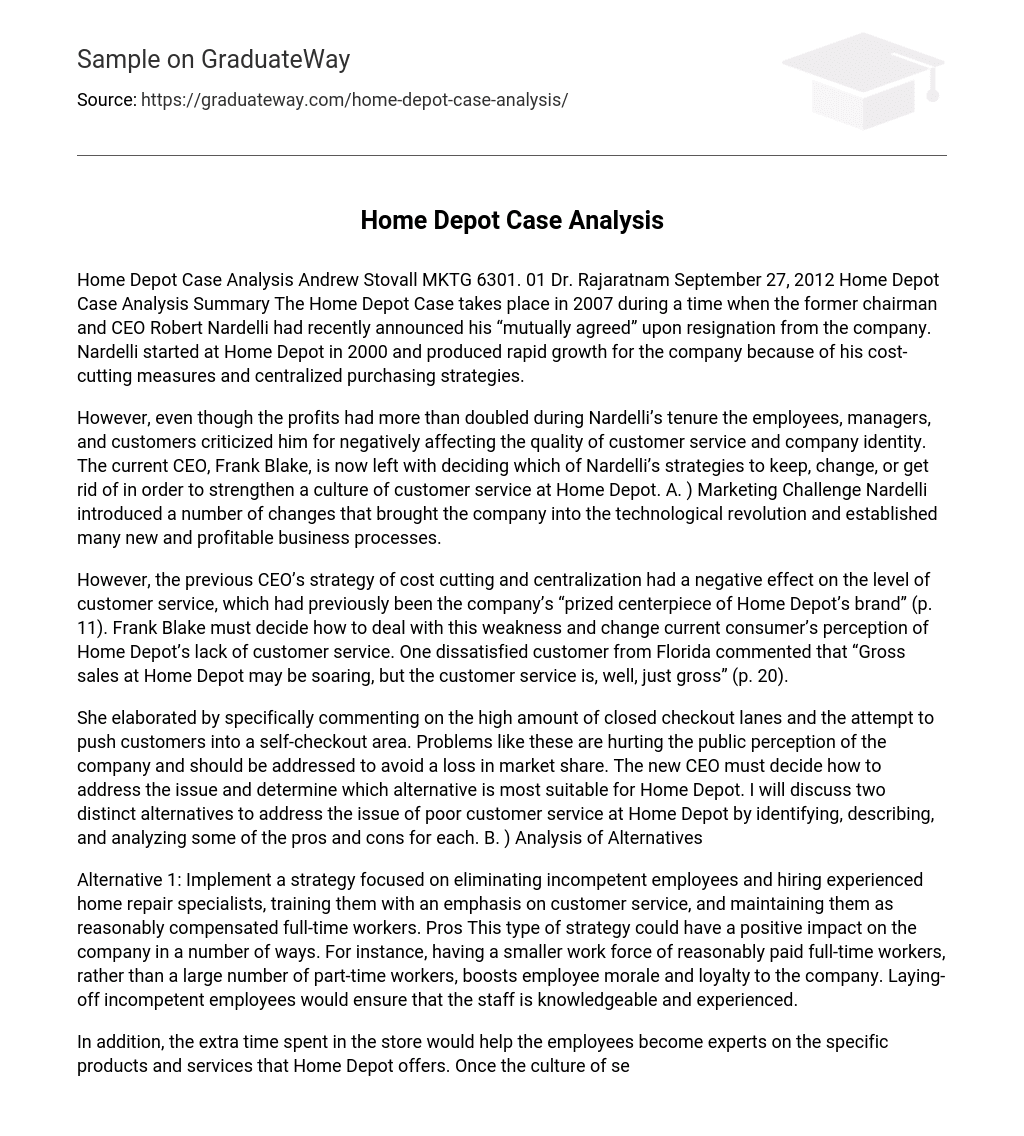In 2007, the Home Depot Case revolved around the resignation of former chairman and CEO Robert Nardelli. Nardelli had joined Home Depot in 2000 and implemented effective measures such as cost-cutting and centralized purchasing, leading to rapid growth for the company.
Despite the profits more than doubling under Nardelli’s leadership, employees, managers, and customers voiced concerns about the decline in customer service quality and company identity. The current CEO, Frank Blake, must now assess which of Nardelli’s strategies to retain, modify, or eliminate in order to enhance a customer service culture at Home Depot. A.) Marketing Challenge Nardelli implemented various changes that embraced the technological revolution and implemented numerous new and lucrative business practices.
Despite the negative impact on customer service caused by the previous CEO’s cost cutting and centralization strategy, which had been a crucial aspect of Home Depot’s brand, Frank Blake needs to address this weakness and alter the current perception of the company’s poor customer service. A dissatisfied customer in Florida expressed their disappointment, stating that while Home Depot’s gross sales may be increasing, the customer service is, in the customer’s words, unpleasant.
She commented on the numerous closed checkout lanes and the effort to direct customers to a self-checkout area, which is negatively affecting public perception of the company. To prevent a decline in market share, these issues should be resolved. The new CEO needs to decide how to tackle the problem and evaluate the most appropriate alternative for Home Depot. I will examine two different options for improving customer service at Home Depot and assess the advantages and disadvantages of each. B.)
Analysis of Alternatives
Alternative 1: To improve the company, a strategy can be implemented which centers on terminating incompetent employees and hiring experienced home repair specialists. These specialists will be trained with a focus on customer service and will be retained as full-time employees with reasonable compensation. Prospective advantages of this strategy include enhancing the company through various means. For instance, having a smaller team of reasonably compensated full-time workers, instead of numerous part-time workers, enhances employee morale and loyalty towards the company. The termination of inefficient employees ensures a knowledgeable and experienced staff.
In addition, the increased amount of time allocated to employees at the store will contribute to their enhanced understanding of Home Depot’s distinct products and services. This advancement in the service culture will draw customers’ interest, enabling the marketing team to incorporate genuine customer testimonials that highlight Home Depot’s exceptional service into their advertising campaigns. The restoration of Home Depot’s esteemed status as a popular destination with amiable, knowledgeable, and talented staff would represent a substantial improvement from its current public perception.
Implementing a strategy focused on this alternative comes with drawbacks. Firstly, the company would need to allocate more funds for providing benefits to full-time employees who were previously part-timers. Additionally, laying off a significant number of employees might be viewed negatively by investors, leading to a decline in the stock price. Moreover, reducing the workforce would increase the workload for remaining staff and could affect service time. It is clear that there are disadvantages associated with this alternative that the CEO must take into account.
Alternative 2: Home Depot could implement a strategy that mandates all employees, present and future, to complete a series of classes and training sessions focused on customer service. This initiative, called “Home Depot U,” would require workers to earn a “diploma” in customer service. Despite the majority of employees remaining part-time, this approach offers several advantages. By providing education at all levels of customer service, the company would benefit greatly. Additionally, Home Depot would continue to save on costs associated with providing benefits to full-time employees. Furthermore, any knowledge gaps among the current part-time staff can be addressed through the comprehensive training provided by the “Home Depot U” program.
Enhancing the expertise of existing staff members is beneficial for customer service without increasing their workload. Additionally, the marketing department can prioritize “Home Depot U” in the marketing plan and leverage the concept of employees earning a “diploma” to better assist customers. By prominently featuring the university theme in stores and advertisements, consumers will be aware of Home Depot’s dedication to delivering outstanding customer service. However, there are some drawbacks to consider.
Acknowledging that choosing this option has negative consequences is important. For example, the implementation of the company-wide “Home Depot U” training program would require significant resources and effective communication and collaboration among all departments. Additionally, some employees may not be willing to invest their time and effort in a rigorous training program for a part-time job. These concerns should be taken into consideration by the CEO during the decision-making process.
When making the decision, it is crucial to consider variables such as the economy, demographics, and competition while also aligning with Home Depot’s mission. Based on my evaluation of the marketing issue, I recommend that Home Depot implement alternative 2 and commit to the “Home Depot U” training program. There are several reasons why I believe this is the best choice; firstly, I will discuss the quantitative analysis.





